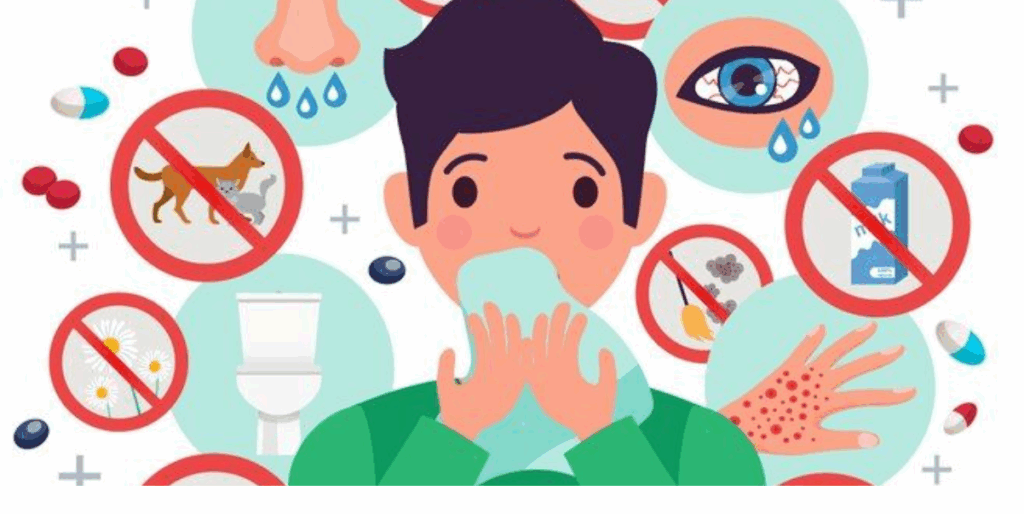What are allergies?
Allergies are a widespread health issue, impacting millions globally. Currently, roughly 30-40% of individuals suffer from at least one allergy, and cases have been steadily rising over the last two decades. Typical triggers include pollen, specific foods, animal dander, and dust mites, though other forms—such as reactions to medications, insect bites, latex, skin irritants, and chemicals—also exist.
According to the World Health Organization (WHO), allergic rhinitis (commonly known as hay fever) and asthma are prevalent allergy-related disorders that can impair breathing and reduce quality of life, often requiring expensive treatment. Researchers suggest that worsening air pollution and climate change may intensify allergies in the future by increasing pollen counts, expanding insect populations, and promoting mold growth—all of which can aggravate symptoms.
Food allergies also affect a significant portion of the global population, with an estimated 2-10% of adults and children experiencing them. Peanuts, tree nuts, eggs, dairy, and seafood are among the most frequent triggers. While food allergies have become more common in Western nations, they remain relatively rare in certain regions of Asia and Africa.
Cause of allergies
Understanding Allergic Reactions
Allergies vary from person to person, so identifying your specific triggers is key. Different substances—whether environmental, food-related, or drug-based—can provoke reactions. Common allergens include:
Pollen (from trees, grasses, or weeds)
Dust mites
Pet dander (from cats or dogs)
Insect stings (such as bees or wasps)
Mold spores
Certain foods
Medications
Allergies generally fall into two categories based on their mechanism: IgE-mediated (the primary focus of this site) and non-IgE-mediated reactions.
IgE-Mediated Allergies
In this type of allergy, the immune system produces IgE antibodies tailored to a specific allergen (e.g., pollen or peanuts). These antibodies bind to mast cells—immune cells found in the skin, respiratory tract, and digestive system—in a process called sensitization. Initially, sensitization causes no symptoms, but it primes the body to react upon future exposure.
When the allergen reappears, mast cells detect it and release histamine and other chemicals, triggering allergy symptoms. This response is the body’s misguided attempt to defend itself.
Non-IgE-Mediated Allergies
Less common and not as well understood, these allergies involve T-cells (a type of white blood cell) rather than IgE antibodies. They’re often linked to conditions like allergic contact dermatitis (contact eczema). Unlike IgE reactions, which are rapid, non-IgE allergies may take 24–48 hours to develop after exposure.
Types of Allergic Reaction
Allergic reactions can vary each time you’re exposed to an allergen. Some symptoms appear quickly, while others develop more slowly. There are two main types of allergic responses to be aware of.
Acute Response (Immediate Reaction)
This is the most common type of allergic reaction, occurring within 15–30 minutes of exposure. The body releases chemicals such as histamine, prostaglandins, and leukotrienes, triggering symptoms like sneezing, swelling, and increased mucus production in the airways. These reactions can also lead to nasal congestion, breathing difficulties, and wheezing.
Late-Phase Response (Delayed Reaction)
This reaction typically begins 4–6 hours after the initial symptoms fade and can persist for days or even weeks. During this phase, the immune system causes inflammation and tissue damage, resulting in increased swelling, fluid buildup (edema), and worsening respiratory issues. This delayed response explains why allergy symptoms sometimes appear or intensify hours after exposure.

Signs and Symptoms of allergic reaction
Mild to Moderate Allergic Reaction:
Skin:
Itching, redness, hives (raised, red welts)
Swelling (face, lips, tongue)
Eyes:
Redness, itching, watery eyes
Nose & Throat:
Sneezing, runny or stuffy nose
Itchy or scratchy throat
Respiratory:
Mild wheezing or coughing
Digestive:
Nausea, vomiting, diarrhea
Severe Allergic Reaction (Anaphylaxis) – EMERGENCY!
Breathing:
Trouble breathing, wheezing, tightness in throat
Swelling:
Severe swelling of lips, tongue, or throat
Circulation:
Rapid or weak pulse, dizziness, fainting
Skin:
Pale or blue skin (in severe cases)
Digestive:
Severe vomiting or diarrhea
Mental State:
Confusion, sense of doom
Common Triggers:
Foods (nuts, shellfish, eggs, milk)
Insect stings (bees, wasps)
Medications (penicillin, aspirin)
Latex, pollen, pet dander
What to Do:
✔ Mild reaction: Antihistamines (e.g., Benadryl)
✔ Severe reaction (anaphylaxis):
Use epinephrine (EpiPen) if available
Call emergency services (911 or local emergency number)
Lie down with legs elevated (if dizzy)
